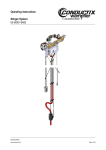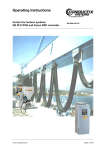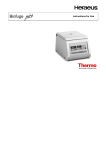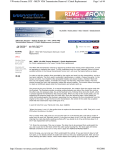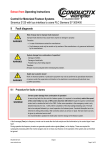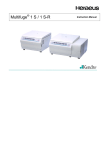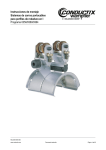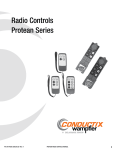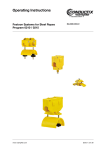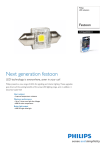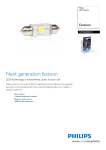Download Festoon, Heavy Duty, 314/315/320/325/330
Transcript
Operating Instructions Festoon Systems for I-Beams Program 0314 / 0315 / 0320 / 0325 / 0330 www.conductix.com BAL0300-0007-E Page 1 of 37 Operating Instructions Festoon Systems for I-Beams Program 0314 / 0315 / 0320 / 0325 / 0330 Contents BAL0300-0007-E Page 1 Target audience for operating instructions ............................................................... 4 2 General information ................................................................................................... 4 2.1 General safety information ........................................................................................ 4 2.1.1 Safety and hazard information .................................................................................. 4 2.2 General safety regulations and organization ............................................................. 5 2.3 Special safety notes .................................................................................................. 5 2.4 Information regarding protection from hazards ........................................................ 7 2.4.1 Mechanical hazards .................................................................................................. 7 2.4.2 Electrical hazards ...................................................................................................... 7 2.5 Technical status ........................................................................................................ 8 2.5.1 Technical Data........................................................................................................... 8 2.5.2 Repeat inspections.................................................................................................... 8 2.6 Intended use.............................................................................................................. 9 2.6.1 How to use the operating manual ............................................................................. 9 3 Special instructions ................................................................................................. 10 3.1 Track beam ............................................................................................................. 10 3.2 Complete assembly................................................................................................. 15 3.3 Adjusting the running gear of the cable trolleys ...................................................... 16 3.4 Attaching the end clamp to the beam ..................................................................... 16 3.5 Attaching the towing clamp to the crane towing arm ............................................. 18 3.6 Festoon systems with towing trolley, crane interface ............................................. 19 3.7 Running cables ........................................................................................................ 20 3.7.1 Running round cables ............................................................................................. 20 3.7.2 Arrangement of flat cables ...................................................................................... 21 www.conductix.com Page 2 of 37 Operating Instructions Festoon Systems for I-Beams Program 0314 / 0315 / 0320 / 0325 / 0330 BAL0300-0007-E 3.8 Cable clamps .......................................................................................................... 22 3.8.1 Round cable clamps ............................................................................................... 22 3.8.2 Mounting the round clamps .................................................................................... 22 3.9 Spacers ................................................................................................................... 24 3.9.1 Flat cable clamp ...................................................................................................... 24 3.10 Towing rope ............................................................................................................ 25 3.10.1 Mounting the towing rope ....................................................................................... 25 3.10.2 Inspection of towing ropes and criteria for replacement ........................................ 26 3.10.3 Maintenance of towing ropes .................................................................................. 27 3.11 Damping devices..................................................................................................... 28 4 Commissioning the festoon system ........................................................................ 29 4.1 Inspections after installing the festoon system ....................................................... 29 4.2 Functional testing of the festoon system ................................................................ 29 4.3 Operating the festoon system ................................................................................. 29 5 Maintenance ............................................................................................................ 30 5.1 Inspection ................................................................................................................ 30 5.1.1 Inspecting the deactivated system ......................................................................... 30 5.1.2 Inspecting the activated system ............................................................................. 31 5.2 Service..................................................................................................................... 32 5.2.1 Wearing parts .......................................................................................................... 33 5.2.2 Wear Limits ............................................................................................................. 33 5.2.3 Spare parts .............................................................................................................. 34 5.3 Repair ...................................................................................................................... 34 6 Copyright ................................................................................................................. 35 7 Product observations .............................................................................................. 35 www.conductix.com Page 3 of 37 Operating Instructions Festoon Systems for I-Beams Program 0314 / 0315 / 0320 / 0325 / 0330 1 BAL0300-0007-E Target audience for operating instructions The operating instructions are intended for qualified personnel who install the festoon systems, operate them and who are familiar with the requirements regarding work safety and accident prevention. 2 General information 2.1 General safety information 2.1.1 Safety and hazard information The following symbols and designations are used in these operating instructions as safety and/or hazard information: WARNING! Bodily Harm! Serious physical injury or fatal accidents may result if work and operating instructions with this symbol are ignored or not followed properly. Notices in the “Warning” category are to be strictly followed. ATTENTION! Machine/Property Damage! Serious machine or material damage may result if work and operating instructions with this symbol are ignored or not followed properly. Notices in the “Attention” category are to be exactly followed. * INFORMATION! Work is facilitated if you follow advice and operational instructions with this symbol. INFORMATION! Refers to another applicable document www.conductix.com Page 4 of 37 Operating Instructions Festoon Systems for I-Beams Program 0314 / 0315 / 0320 / 0325 / 0330 2.2 BAL0300-0007-E General safety regulations and organization The operating instructions must always be stored in a readily accessible on-site location near the festoon system. In addition to the operating instructions, general regulations regarding accident prevention and environmental protection are to be observed. The operator must observe the following standards and regulations when operating a festoon system: 98/37/EG 73/23/EWG 93/68/EWG DIN EN ISO 12100 EU Machinery Directive EU Low Voltage Directive IEC 60038 Machine Safety IEC standard voltages IEC 60364 Electrical installations of buildings IEC 60947 Low-voltage switchgear and controlgear Accident prevention regulations • Installation, set-up, maintenance and operation of the festoon system must be performed by sufficiently qualified and trained specialists. • Before beginning work, operation and maintenance personnel must have read and understood the operating instructions and safety guidelines, in particular. Protective gear for operation and maintenance personnel must be provided and used. • The system operator or his/her representative is to supervise machine operation to ensure the safety of personnel when working on or with the system. 2.3 Special safety notes Transport / Installation: • Individual parts and larger assembly groups are to be secured on suitable hoisting devices or load-carrying equipment that are in good working order and have sufficient load capacity. For electrical and mechanical connections: • Connections are only to be made by personnel specially trained for the given task. For commissioning and operation: • Before initial commissioning and daily start-up, a visual check and predefined inspection procedure is to be performed (see Chapter 4). • Any procedures that could threaten safety are to be avoided. • The system should only be operated with functional protective gear and safety devices. www.conductix.com Page 5 of 37 Operating Instructions Festoon Systems for I-Beams Program 0314 / 0315 / 0320 / 0325 / 0330 BAL0300-0007-E • Notify the responsible party immediately in case of damage to the festoon system. • Protect the festoon system from accidental or unauthorized operation. • It is forbidden to enter the operating area of the festoon system. See also intended use in Chapter 2.6. For cleaning / service / repair / maintenance / reconditioning: • Turn off power supply and ensure that no inadvertent activation is possible. • When installation tasks are carried out above eye level, use proper climbing aids and working platforms. • Do not climb on machine components. • Check cables for wear or damage. • Ensure that exhaust, collection and disposal of process materials be done in a safe and environmentally-friendly manner. • Safety devices that are removed for installation, service or repair must be remounted and inspected after work is completed. • Observe the inspection and maintenance intervals described in the maintenance instructions. • Observe the directions in the operating and maintenance instructions for replacing parts. • Ensure that sufficient space for maintenance work is available. • Ensure that the festoon system is not inadvertently activated during maintenance work. • Ensure that detached parts do not fall. • Screw joints that are disconnected during maintenance work are to be reattached and secured as instructed. • Fasteners and seals that cannot be reused are to be replaced (such as self-locking nuts, disks, splints, O-rings, glued or microencapsulated screws). • Lubrication points that are cleaned or wiped during maintenance and repair work must be re-lubricated as instructed. • After finishing work, collect all tools and materials and check that all are present. • Disassembled parts and components that were replaced are to be collected, stored in a safe place, recycled, or sent back. www.conductix.com Page 6 of 37 Operating Instructions Festoon Systems for I-Beams Program 0314 / 0315 / 0320 / 0325 / 0330 2.4 BAL0300-0007-E Information regarding protection from hazards Hazard areas must be identified with warning signs and be protected with barriers. Ensure that hazard area notices are observed. Hazards can result from • improper use • failure to adequately observe safety notices • inadequate inspection and maintenance work 2.4.1 Mechanical hazards WARNING! Bodily harm! Unconsciousness and injury due to - crushing, pinching, cutting, wrapping - retracting, blunt collision, stabbing, grinding - slipping, stumbling, falling Causes: - Areas where danger of crushing, pinching and wrapping exists - Part failure or explosion Ways to protect yourself: - Keep floors, devices, and machines clean. - Repair leaks. - Observe the required safety distance. 2.4.2 Electrical hazards All errors must be analyzed before remedying the problem. Work on electrical systems or production equipment may only be performed by specialized electricians or persons under the supervision and direction of an electrician in accordance with electrical rules (qualified personnel). WARNING! Bodily harm! Death due to electric shock, injury and burns due to Touching live sources Faulty insulation Inadequate maintenance and repair Short circuits Causes: - Touching or coming too close to uninsulated current-bearing parts - Using uninsulated tools - Current-bearing parts that are laid bare due to insulation failure - Inadequate safety checks after maintenance work - Use of improper fuses www.conductix.com Page 7 of 37 Operating Instructions Festoon Systems for I-Beams Program 0314 / 0315 / 0320 / 0325 / 0330 BAL0300-0007-E Ways to protect yourself: - Ensure that current to machines and system parts that are to undergo maintenance work is turned off and protected against reactivation. - Check parts to ensure that they are free of current. Cover and isolate nearby live parts. - Check electrical equipment regularly. - Immediately replace loose or damaged cable or lines. - Always replace blown fuses with identical fuses. - Avoid touching live parts. - Use insulated tools. 2.5 Technical status These operating instructions were prepared in May 2007. 2.5.1 Technical Data INFORMATION! See project-specific technical documentation such as system sketches, cable running suggestions, and round or flat cable clamp layout. 2.5.2 Repeat inspections Every operator is to record all inspection, service and maintenance tasks in a machine book in an orderly manner. This is to be confirmed by a technical expert. In case of inaccurate or missing entries, the warranty is rendered null and void. CAUTION! System or property damage! Devices and systems are to be periodically inspected by an expert. In general, visual and functional checks are to be performed. The condition of components with regard to damage, wear, corrosion or other damage is to be determined. Generally speaking, the completeness and functionality of the safety equipment is evaluated. To better evaluate the wear and tear of parts, disassembly may be required. CAUTION! System or property damage! All regular inspections are to be performed by the operator. www.conductix.com Page 8 of 37 Operating Instructions Festoon Systems for I-Beams Program 0314 / 0315 / 0320 / 0325 / 0330 2.6 BAL0300-0007-E Intended use The festoon system is built in accordance with recognized safety/technical regulations using the latest technology and has been checked for safety compliance by the manufacturer. Only festoon systems that are in good technical condition may be employed for their intended use. These may only be operated by trained personnel aware of safe operating practices and possible hazards. Intended use of the system also includes the observance of manufacturer operation, service, and maintenance requirements. See Chapter 4. Non-intended use includes the following: • Exceeding projected load capacities • Exceeding projected speeds • Excessive braking deceleration • Use of inappropriate cables (see also Chap. 2.5) • Changing atmospheric conditions (including a change to projected physical location) • Bridging and/or deactivating electrical sensors or switches • Use of technically inappropriate guide systems (such as inappropriate or corroded track beams, poorly aligned girder joints, etc.), see Chap. 2.1. • The presence of projecting edges on the surrounding steel framework too close to the cable trolley The manufacturer is in no way liable for damages to the system or third parties resulting from non-intended use. 2.6.1 How to use the operating manual As a supplement to the operating instructions, the operator must observe the following documentation (if available): • Project-specific technical documentation • Installation instructions, see Chap. 2 • Maintenance instructions, see Chap. 4 • Drawings • Spare part lists • Sketches www.conductix.com Page 9 of 37 Operating Instructions Festoon Systems for I-Beams Program 0314 / 0315 / 0320 / 0325 / 0330 3 Special instructions 3.1 Track beam BAL0300-0007-E The operator is basically responsible for ensuring that the track beam is securely fastened as well as checking it for wear, corrosion or defects. The following procedures are to be observed when installing the track beam: CATION! System or property damage!! - In general, track beams are to be protected from corrosion using appropriate measures. - The running surfaces of the main rollers and the horizontal guide rollers must be clean and free of objects or defects that could damage the rollers (scratches, cracks, holes, uneven segments, etc.). - If multiple beams are welded together, they must all have the same measurements and positional tolerances. - The beam flanges are to be aligned with particular care in horizontal and vertical planes. - Track beams that have been damaged during transport or rolling must not be used. - Modified areas (from welding, sanding, etc.) on the track beam are to be protected from corrosion with appropriate measures. Sketch 1: Smoothing of welded track beams CAUTION! System or property damage! Bumps and uneven areas on all sides of the welded track beams are to be sanded smooth for a length of 100 mm. NOTE! Required tools and materials: * sanded sanded sanded www.conductix.com sanded Page 10 of 37 Operating Instructions Festoon Systems for I-Beams Program 0314 / 0315 / 0320 / 0325 / 0330 BAL0300-0007-E Sketch 2: Use of even welded track beams CAUTION! System or property damage! Welded joints on the track beams must be even at points that could come into contact with the cable trolleys. Fasteners and suspended objects that could come into contact with the cable trolleys are not permitted No uneven areas, fasteners, suspended objects, etc. Sketch 3: Girder joint for non-welded track beams: CAUTION! System or property damage! For non-welded girder joints, the gap between girders must not exceed 5 mm. The cut is at a 45° angle. * NOTE! Required tools and materials: www.conductix.com Page 11 of 37 Operating Instructions Festoon Systems for I-Beams Program 0314 / 0315 / 0320 / 0325 / 0330 BAL0300-0007-E Sketch 4: Girder joint for non-welded track beams: CAUTION! System or property damage! For non-welded girder joints, the horizontal and vertical separation between girders must not exceed 2 mm. Transitions must be ground smooth within about 100 mm of the beginning of the cut. All transitions must be beveled and rounded * NOTE! Required tools and materials: Horizontal and vertical deviation ±2 mm Edges beveled and rounded Edges beveled and rounded Smooth and clean the transitions in all directions up to 100 mm away from the beginning of the cut! www.conductix.com Page 12 of 37 Operating Instructions Festoon Systems for I-Beams Program 0314 / 0315 / 0320 / 0325 / 0330 BAL0300-0007-E Sketch 5: Horizontal deviation of track beams CAUTION! System or property damage! The horizontal deviation over the length of the track beam may not exceed ±5 mm. For lengths shorter than 2 m, deviation may not exceed ±2 mm. * NOTE! Required tools and materials: Sketch 6: Vertical deviation of track beams CAUTION! System or property damage! The vertical deviation over the length of the track beam may not exceed ±5 mm. For lengths shorter than 2 m, deviation may not exceed ±2 mm. www.conductix.com Page 13 of 37 Operating Instructions Festoon Systems for I-Beams Program 0314 / 0315 / 0320 / 0325 / 0330 BAL0300-0007-E Sketch 7: Poor horizontal alignment between the operator’s crane beam and the track beam CAUTION! System or property damage! The horizontal alignment gap between the crane beam and track beam must not exceed ±7.5 mm. This tolerance should include a possible alignment deviation of the trolley winch. * NOTE! Required tools and materials: Crane beam Track beam Sketch 8: Poor vertical alignment between the crane beam and track beam CAUTION! System or property damage! The horizontal alignment gap between the crane beam and track beam must not exceed ±15 mm. This tolerance should include a possible alignment deviation of the main trolley of the crane. Crane beam Track beam www.conductix.com Page 14 of 37 Operating Instructions Festoon Systems for I-Beams Program 0314 / 0315 / 0320 / 0325 / 0330 3.2 * BAL0300-0007-E Complete assembly NOTE! The use of a pre-assembled festoon system (with pre-attached cables on the cable trolley) will save a significant amount of time and money. In this case, the complete system is delivered on a mounting structure and inserted into the front of the track beam. WARNING! Danger of bodily harm! - Lifting of loads may only be performed by qualified specialists. - Safety regulations must be observed. - General legal regulations regarding accident prevention and environmental protection are to be observed. - Loads are to be carefully secured onto suitable hoists or load-carrying devices that are technically intact and have sufficient load capacity. - The use of a load track may be required, depending on the weight of the system. - Before lifting a mounting structure, ensure that the festoon system is firmly installed on the mounting structure. - Only lift mounting structures in a horizontal position. Sketch 9: Complete assembly Load Track www.conductix.com Page 15 of 37 Operating Instructions Festoon Systems for I-Beams Program 0314 / 0315 / 0320 / 0325 / 0330 3.3 BAL0300-0007-E Adjusting the running gear of the cable trolleys The horizontal guide rollers of the cable trolley are delivered set to the maximum width tolerance indicated for the track beams stated at the time of ordering, with the exception of Prog. 0314. Sketch 10: Adjusting the horizontal guide rollers to the actual width of the beam CAUTION! System or property damage! - Distance A between both sides of the cable trolley should not exceed the beam width by more than 40 mm. - After adjusting the side section, ensure the screws are properly secured. Track beam Side shields 3.4 Attaching the end clamp to the beam When attaching the end clamp to the beam, the following should be observed (see Sketch 11): CAUTION! System or property damage! - Height differences greater than 5 mm between the cable trolley and the end clamp buffer must be compensated for by installing a filler plate (see Sketch 11). When installing the cable trolley with a buffer on one side, ensure that contact is always between buffers or between the buffer and the end stop, but that end stops do not collide. - The end clamp should be installed and adjusted with deviation of no more than 1° (see Sketch 13) from the longitudinal and transverse axes of the track beam. - To take up the buffer energy, a shear plate is to be attached (see Sketch 13). www.conductix.com Page 16 of 37 Operating Instructions Festoon Systems for I-Beams Program 0314 / 0315 / 0320 / 0325 / 0330 BAL0300-0007-E Sketch 11: Height equalization of the end clamp by a steel packing plate. Track beam max. permissible height offset Δh 5 mm. If Δh is greater than 5 mm: use steel packing plate! Track beam Sketch 12: Permissible deviation between end clamp and track beam Track beam End clamp www.conductix.com permitted deviation: 1° Page 17 of 37 Operating Instructions Festoon Systems for I-Beams Program 0314 / 0315 / 0320 / 0325 / 0330 BAL0300-0007-E Sketch 13: Welded shear plate on the track beam * NOTE! Required tools and materials: Track beam Welded shear plate 3.5 End clamp Attaching the towing clamp to the crane towing arm CAUTION! System or property damage! - Height differences between the cable trolley buffer and the towing clamp buffer or towing clamp deflector must be equalized using a filler plate. - When installing the cable trolley with a buffer on one side, ensure that contact is always between buffers or between the buffer and the end stop, but that end stops do not collide. - The towing clamp should be installed and adjusted with a deviation of no more than 1° from the longitudinal and transverse axes of the track beam. - The free space [h] between the towing arm and the lower border of the track beam must be at least 12 mm. www.conductix.com Page 18 of 37 Operating Instructions Festoon Systems for I-Beams Program 0314 / 0315 / 0320 / 0325 / 0330 BAL0300-0007-E Sketch 14: Permissible deviation between towing clamp and track beam permissable deviation max. 1° 3.6 Festoon systems with towing trolley, crane interface CAUTION! System or property damage! The towing arm must have enough play in the opening (towing window) in all directions. The towing arm is to be aligned to the center of the towing window. Sketch 15: Aligning the towing arm in the towing window Towing Arm Towing unit www.conductix.com Page 19 of 37 Operating Instructions Festoon Systems for I-Beams Program 0314 / 0315 / 0320 / 0325 / 0330 3.7 BAL0300-0007-E Running cables CAUTION! System or property damage! Only suitable flexible cables may be used. 3.7.1 Running round cables CAUTION! System or property damage! Improper arrangement of cables in the cable package and in loops can damage the cables and the festoon system. The projected cable setup for the festoon system is to be maintained. The following rules are recommended: • Place the cable package into the track beam so that the balance of torque is in the middle. • Cables with large copper diameters are to be placed towards the center of the trolley and arranged symmetrically. • When using cable trolleys with multiple cable support, the heaviest cables are to be placed on the uppermost support. • When using cable trolleys with multiple cable support, the uppermost cables should be made slightly shorter than the cables below. Each layer of cables should be given somewhat less play than the cables below them. • When using round cable clamps, cables should be run on the outer surface of the supports that are suitable for anchoring the round cable clamps. Unshielded cables with a large copper diameter are preferred. • The clamping bars of the cable supports are to be screwed on tightly enough that thin cables are not pulled through during operation, but that cables are not damaged by being over-tightened. If necessary, clamping pieces can be used. Sketch 16: Diameter differences If possible, the diameter of the round cables should be fairly uniform. This helps to prevent them from getting clamped on the cable supports. www.conductix.com Page 20 of 37 Operating Instructions Festoon Systems for I-Beams Program 0314 / 0315 / 0320 / 0325 / 0330 BAL0300-0007-E Sketch 17: Using Clamping Pieces For differences in diameter for adjacent cables that are more than 15 mm, clamping pieces are to be used for tight clamping. Clamping piece Sketch 18: Balance of cable torque Pay attention to the balance of torque when positioning the cables. The thicker, heavier cables are to be placed in the middle. Balanced Very good 3.7.2 Unbalanced Inadmissable Arrangement of flat cables CAUTION! System or property damage! Improper arrangement of cables in the cable package and in loops can damage the cables and the festoon system. The projected cable setup for the festoon system is to be maintained. The following rules are recommended: • Balance of torque of the cable package to the track beam center • When using layered flat cables, give each layer of cables slightly less slack than the layer below. • When using cable trolleys with multiple cable supports, the uppermost cables should be made slightly shorter than the cables below. Each layer of cables should be given somewhat less play than the cables below them. • Cables with a large copper diameter are to be placed symmetrically to the center of the cable trolley and at the top of the cable package. • When using flat cable clamps, only the uppermost cables are clamped. The other cables must be freely movable in the flat cable clamp window. www.conductix.com Page 21 of 37 Operating Instructions Festoon Systems for I-Beams Program 0314 / 0315 / 0320 / 0325 / 0330 BAL0300-0007-E Sketch 19: Very good 100% clamping Good 50% clamping Poor Sketch 20: Thicker cables (such as 4x50) are to be placed at the top of the cable package. This allows for good heat dissipation and solid clamping of smaller cables. Traction forces that occur during movement can be taken up by these cables. 3.8 3.8.1 Cable clamps Round cable clamps CAUTION! System or property damage! - Improper positioning of the round cable clamps can lead to damage of the cables and festoon system. - Improper mounting and arrangement of cables in the round cable clamp can damage the cables and the festoon system. 3.8.2 * Mounting the round clamps NOTE! Required tools and materials: www.conductix.com Page 22 of 37 Operating Instructions Festoon Systems for I-Beams Program 0314 / 0315 / 0320 / 0325 / 0330 BAL0300-0007-E Sketch 21: Mounting the round cable clamps mounted Not mounted Inner cable loose Outer cable damped Clamp round cable with Profile side Spacer It is recommended that the round cable clamps be preassembled as shown in this diagram in order to maintain two identical halves. Diagram for round cable clamp subassembly Clamped Loos Clamped The outer left and right cables are firmly clamped between the rubber profiles. Ensure that the inner cables can move freely in the round cable clamp window. If spacers need to be used (in order to prevent turning and superimposition of cables), insert them before closing the cable clamp. The use of spacers depends on the diameter of the cables. The cable clamp screws must be lubricated. Screws must be tightened crosswise. www.conductix.com Page 23 of 37 Operating Instructions Festoon Systems for I-Beams Program 0314 / 0315 / 0320 / 0325 / 0330 3.9 BAL0300-0007-E Spacers CAUTION! System or property damage!! Improper positioning or removal of spacers in round cable clamps can cause damage to the cables or the festoon system. Sketch 22: Spacer 3.9.1 Flat cable clamp CAUTION! System or property damage! - Improper positioning of the flat cable clamps can lead to damage of the cables and festoon system. - Improper mounting and arrangement of cables in the flat cable clamp can damage the cables and the festoon system. - Clamp the uppermost cables in the flat cable clamp. The other cables must be freely movable in the flat cable clamp window. Sketch 23: www.conductix.com Page 24 of 37 Operating Instructions Festoon Systems for I-Beams Program 0314 / 0315 / 0320 / 0325 / 0330 BAL0300-0007-E Sketch 24: Power cables clamped Control cables with free space in the window 3.10 Towing rope CAUTION! System or property damage! Ensure that the shackles and thimbles can be freely moved after installation. Sketch 23: 3.10.1 Mounting the towing rope * NOTE! Required tools and materials: The towing rope is mounted between two cable trolleys. Ensure that the shackles can be easily moved after tightening the self-locking nut. The shackles must be serviced at regular intervals (see the section “Maintenance”). If towing ropes are used with retaining bushes, the retaining bushes must be pressed or hammered into the drill hole in the center plate of the cable trolley. www.conductix.com Page 25 of 37 Operating Instructions Festoon Systems for I-Beams Program 0314 / 0315 / 0320 / 0325 / 0330 BAL0300-0007-E Sketch 25: Towing rope grease Shackle must be able to move freely after mounting 3.10.2 Inspection of towing ropes and criteria for replacement In case of defects, towing ropes are to be taken out of operation immediately and replaced. A towing rope must be replaced if one or more of the following criteria are fulfilled: 1 Wire breakage 2 Structural changes 3 Corrosion 4 Abrasion CAUTION! System or property damage! Towing ropes must be inspected at regular intervals. The inspections must be performed at least every 12 months. The following cable deformations are grounds for replacement: • Corkscrew-like deformation: A towing rope must be replaced if it has corkscrew deformations with waves that measure more than a third of the cable diameter. • Fraying: Replace the cable if it starts to fray. • Loop formation: Replace the cable if loop formation has led to significant changes in the cable structure. • Loosening: Replace if wires are loosened due to rust or abrasion. • Node formation: Replace if nodes – points where the cable is widened – form in the steel cable. www.conductix.com Page 26 of 37 Operating Instructions Festoon Systems for I-Beams Program 0314 / 0315 / 0320 / 0325 / 0330 BAL0300-0007-E • Constriction: Replace in case of severe constrictions in the cable. • Curling: Replace the towing rope if permanent deformations are present, such as those caused by being pulled over a corner. • Kinks: Replace if kinks form after tension is applied to cable loops. • Bends: Replace the towing rope if it has been bent by an external force. 3.10.3 Maintenance of towing ropes * NOTE! Towing ropes and the accompanying connection elements and stops are to be serviced. We recommend regular maintenance using cable spray every four weeks. www.conductix.com Page 27 of 37 Operating Instructions Festoon Systems for I-Beams Program 0314 / 0315 / 0320 / 0325 / 0330 BAL0300-0007-E 3.11 Damping devices The damping device is to be mounted in accordance with installation instructions. WARNING! Bodily harm! Before performing maintenance or approaching a system with Damping devices, release the Damping devices. CAUTION! System or property damage! Ensure that the mounting eyes and Shackle for the towing rope can be freely moved after installation. * NOTE! Required tools and materials: Sketch 26: Damping Device with 2 shock cords www.conductix.com Page 28 of 37 Operating Instructions Festoon Systems for I-Beams Program 0314 / 0315 / 0320 / 0325 / 0330 4 BAL0300-0007-E Commissioning the festoon system The festoon system is commissioned together with the system operator and is documented. All necessary personnel for commissioning including crane operators, electricians and installation technicians are to be provided by the system operator for the course of commissioning. Free access to the system must be provided. After successful commissioning, Wampfler AG will receive a final handover document that is authorized by the system operator (see the last page of the commissioning checklist) indicating that the system meets all requirements. The commissioning is to be performed based on the “Commissioning Checklist” document. 4.1 Inspections after installing the festoon system • Check the cable trolley for proper condition, function and movement, firm seating and for deformations. • Check electrical connections and supplies for secure guiding and seating. • Check functionality of track beams. • Check the steel construction for projecting edges, firm seating and mobility. 4.2 Functional testing of the festoon system For commissioning, the festoon system must be operated with a nominal load. 4.3 Operating the festoon system For operation, it is mandatory that the safety notices in Chapter 1 are observed. www.conductix.com Page 29 of 37 Operating Instructions Festoon Systems for I-Beams Program 0314 / 0315 / 0320 / 0325 / 0330 5 BAL0300-0007-E Maintenance In order to retain warranty rights and to avoid damage, the system operator is responsible for performing the following maintenance tasks. Inspection, service and repair are to be performed and documented by trained and qualified specialists. The following tasks fall under the category “Maintenance”: Maintenance Service Cleaning Cleansing Conserving Lubricating Expanding Adjusting Inspection Checking Measuring Inspecting 5.1 5.1.1 Maintenance Improving Exchanging Inspection Inspecting the deactivated system WARNING! Bodily harm! Before approaching systems with Damping devices, these must be released. www.conductix.com Component Rollers Buffers Center plates Cable supports Fasteners Cables Cable clamps Fixed installation length Installation connections Towing ropes Towing devices End stops Track beams Task Description - for proper condition - for proper function - for proper mobility Visual Inspection Every 30 days: 2 shift ooperation, at the lataest after 300 operational hours Every 14 days: 3 and 4 shift operation, at the latest after 300 opearational hours Inspections: Interval - for firm seating - for deformations - for wear - for damages - for dirt - for corrosion Page 30 of 37 Operating Instructions Festoon Systems for I-Beams Program 0314 / 0315 / 0320 / 0325 / 0330 5.1.2 BAL0300-0007-E Inspecting the activated system WARNING! Bodily harm! Observe the safety regulations. Component Task Rollers Cable trolleys Towing device Towing ropes Damping devices Track beams and system Function Test Every 30 days: 2 shift ooperation, at the lataest after 300 operational hours Every 14 days: 3 and 4 shift operation, at the latest after 300 opearational hours Inspections Interval Descriptio for easy and unobstructed running of the main rollers, horizontal guide rollers and anti-lift rollers on the track beam running surfaces for proper entry and exit of the cable trolleys in the storage area for reliable operation of the towin devices based on the required horizontal and vertical balancing movements for functionality of the towing ropes and damping devices, especially when the system is completely extended of the track beam and the entire system, for dirt and corrosion that influence functionality Should problems be identified during inspection, the service work shown in Point 5.2 should be performed. www.conductix.com Page 31 of 37 Operating Instructions Festoon Systems for I-Beams Program 0314 / 0315 / 0320 / 0325 / 0330 5.2 BAL0300-0007-E Service WARNING! Bodily harm! Before approaching systems with Damping devices, these must be released. Task Description Tighten all Fasteners. Cable mounting Tighten all Fasteners on clamping bars and cable clamps. Damping device Towing rope Surface/corrosion protection Corrosion protective coating Replace worn parts if necessary. Replace shock cords if necessary. Tighten mounting screws. Lubricate shackles. Improve/replace Towing device Maintenance measure Roller mounting Every 3 monts Every 30 days: 2 shift ooperation, at the lataest after 300 operational hours Component Varies (dependent on external influences) Every 14 days: 3 and 4 shift operation, at the latest after 300 opearational hours Service tasks: Interval Refinish hot-dip galvanized surfaces with zinc coating. Refinish lacquered surfaces. The bearings of the trolley rollers do not require service. www.conductix.com Page 32 of 37 Operating Instructions Festoon Systems for I-Beams Program 0314 / 0315 / 0320 / 0325 / 0330 5.2.1 BAL0300-0007-E Wearing parts Wearing parts are excluded from the warranty. This includes: • • • • • All trolley rollers including main rollers, horizontal guide rollers, counter-pressure rollers Shock cords on damping devices Special damping devices in the towing trolley window Rubber or cellular buffers Other definitions require written documentation. 5.2.2 Wear Limits Component Wear limit has been reached if Rollers - the diameter of the roller has been reduced from the nominal diameter by 2 mm - sharp impressions can be seen - cracks, broken-off pieces, or embrittlements have formed on Vulkollan or Adiprene rollers, or if initial signs that the outer section is disengaging from the core appear - increased bearing play occurs due to worn ball bearings - significant lubrication leakage is seen - the rollers do not run smoothly - cracks, breaks or embrittlements are seen - corrosion protection has failed Buffers Center plates and side shields Cable supports Fasteners Cables Cable clamps Towing ropes Towing devices www.conductix.com - corrosion protection has failed initial signs of cracks in the supports are seen corrosion protection has failed connection integrity (screw joints, clamp connections, glued connections) is no longer ensured wire, shielding or jacket breakage is seen corkscrews have formed corrosion protection has failed cracks and embrittlements are seen in the clamp rubber the clamp does not hold cables sufficiently see Chap. 3.10.2 wires break, structural changes occur, corrosion and abrasion see chapter 3.10.2 if there are broken wires, structural changes, corrosion and wear and tear Page 33 of 37 Operating Instructions Festoon Systems for I-Beams Program 0314 / 0315 / 0320 / 0325 / 0330 Component End clamp Damping devices and shock cords Track beam 5.2.3 BAL0300-0007-E Wear limit has been reached if - corrosion protection has failed - attachment to the track beam is no longer secure - corrosion protection has failed - severe constrictions in the shock cords occur - the mantle of the shock cordis even partially torn - fraying strands on the shock cord appear - mechanical deformations on the shock cord consoles appear - corrosion protection has failed - significant tracks from the rollers of the cable trolley unit appear Spare parts The following spare parts are available: • cable support, complete with clamping bar and fasteners • side shield complete with trolley rollers 5.3 Repair Request a customer service technician from Wampfler AG for all repairs. If qualified service technicians from the system operator perform the repairs themselves, all information contained in these operating instructions must be observed. Wampfler AG accepts no liability or responsibility for damages and production faults that result from failure to follow these operating instructions. For maintenance and repair, only use • suitable tools in good working order • original spare parts from Wampfler AG or spare parts that have been explicitly approved by Wampfler AG www.conductix.com Page 34 of 37 Operating Instructions Festoon Systems for I-Beams Program 0314 / 0315 / 0320 / 0325 / 0330 6 BAL0300-0007-E Copyright This documentation is protected by copyright law. The rights established herein, including translation, reprinting, the use of figures, radio transmission, reproduction using photographic or similar methods or saving in electronic format remain reserved, even for partial use. Wampfler AG reserves the right to make technical changes without informing the recipient of this document / these data. Wampfler AG accepts no liability, inasmuch as this is legally permissible, for errors in this documentation or for damages that occur in connection with delivery and use of the documentation. © Wampfler AG 2007 7 Product observations We strive to observe our products after delivery in order to further improve them and better meet your needs. Please use the form on the following pages to communicate your experiences and issues with us that could be of interest for our improvement process. Thank you very much for your help. For example: • changed configuration data • experiences with the festoon system • recurrent errors • difficulties with documentation www.conductix.com Page 35 of 37 Product Observation Fax to: +49 (0) 7621/662-284 Product Management Festoon systems for I-Beams Prog. 0314 / 0315 / 0320 / 0325 / 0330 Your contact data Company: Department Contact Person Address PO-Box City Phone Email Cust.-No.: Zip code Zip code Fax Your experiences and observations: www.wampfler.com Page 36 of 37 Product Observation Fax to: +49 (0) 7621/662-284 Product Management Festoon systems for I-Beams Prog. 0314 / 0315 / 0320 / 0325 / 0330 www.wampfler.com Page 37 of 37





































